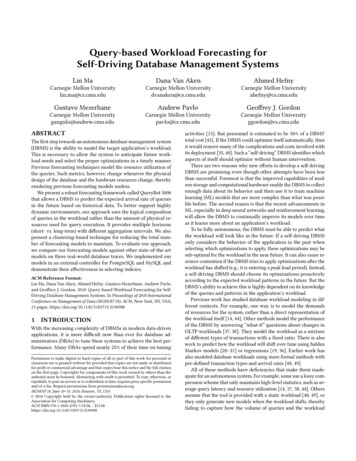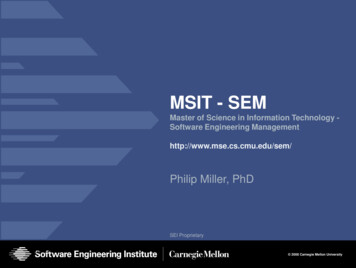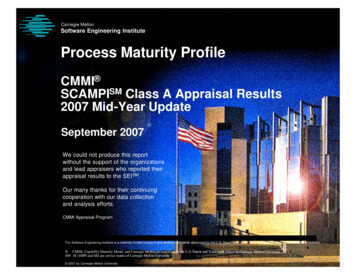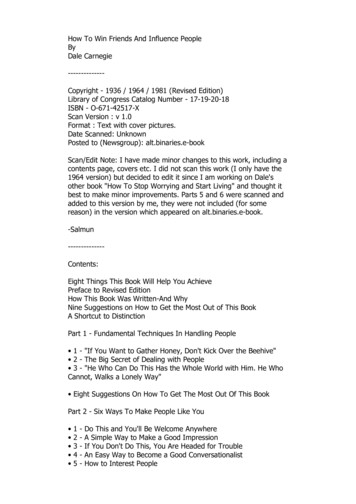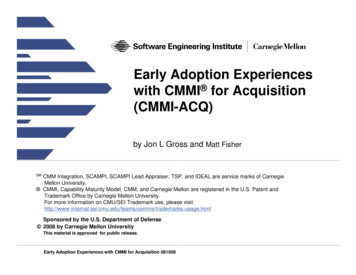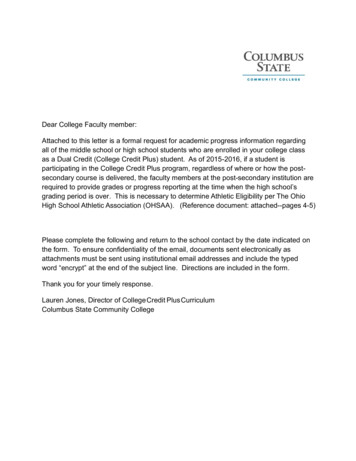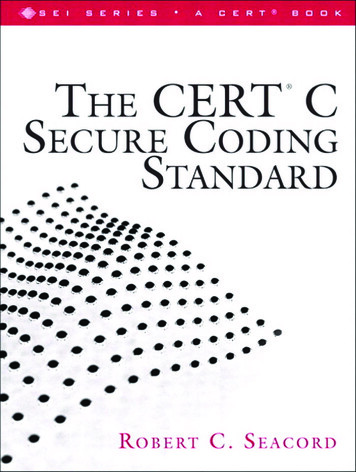
Transcription
Carnegie MellonSoftware Engineering InstituteThe SEI Series in Software EngineeringMany of the designations used by manufacturers and sellers to distinguish their products are claimed as trademarks.Where those designations appear in this book, and the publisher was aware of a trademark claim, the designationshave been printed with initial capital letters or in all capitals.CMM, CMMI, Capability Maturity Model, Capability Maturity Modeling, Carnegie Mellon, CERT, and CERT Coordination Center are registered in the U.S. Patent and Trademark Office by Carnegie Mellon University.ATAM; Architecture Tradeoff Analysis Method; CMM Integration; COTS Usage-Risk Evaluation; CURE; EPIC;Evolutionary Process for Integrating COTS Based Systems; Framework for Software Product Line Practice; IDEAL;Interim Profile; OAR; OCTAVE; Operationally Critical Threat, Asset, and Vulnerability Evaluation; Options Analysisfor Reengineering; Personal Software Process; PLTP; Product Line Technical Probe; PSP; SCAMPI; SCAMPI LeadAppraiser; SCAMPI Lead Assessor; SCE; SEI; SEPG; Team Software Process; and TSP are service marks of CarnegieMellon University.Special permission to use material from the CERT Secure Coding Standards Website, 2007 Carnegie Mellon University, in this publication is granted by the Software Engineering Institute.The author and publisher have taken care in the preparation of this book, but make no expressed or implied warrantyof any kind and assume no responsibility for errors or omissions. No liability is assumed for incidental or consequential damages in connection with or arising out of the use of the information or programs contained herein.The publisher offers excellent discounts on this book when ordered in quantity for bulk purchases or special sales,which may include electronic versions and/or custom covers and content particular to your business, training goals,marketing focus, and branding interests. For more information, please contact:U.S. Corporate and Government Sales(800) 382-3419corpsales@pearsontechgroup.comFor sales outside the U.S., please contact:International Salesinternational@pearsoned.comVisit us on the Web: informit.com/awLibrary of Congress Cataloging-in-Publication DataSeacord, Robert C.The CERT C secure coding standard / Robert C. Seacord.p. cm.Includes bibliographical references and index.ISBN 0-321-56321-2 (pbk. : alk. paper) 1. C (Computer program language) 2. Computer security. I. Title.QA76.73.C15S4155 2008005.8—dc222008030261Copyright 2009 Pearson Education, Inc.All rights reserved. Printed in the United States of America. This publication is protected by copyright, and permissionmust be obtained from the publisher prior to any prohibited reproduction, storage in a retrieval system, or transmission in any form or by any means, electronic, mechanical, photocopying, recording, or likewise. For informationregarding permissions, write to:Pearson Education, Inc.Rights and Contracts Department501 Boylston Street, Suite 900Boston, MA 02116Fax: (617) 671-3447ISBN 13: 978-0-321-56321-7ISBN 10:0-321-56321-2Text printed in the United States on recycled paper at Courier in Stoughton, Massachusetts.First printing, October 2008.
PrefaceAn essential element of secure coding in the C programming language is a well-documentedand enforceable coding standard. Coding standards encourage programmers to follow a uniform set of guidelines determined by the requirements of the project and organization ratherthan by the programmer’s familiarity or preference. Once established, these standards can beused as a metric to evaluate source code (using manual or automated processes).The CERT C Secure Coding Standard provides guidelines for secure coding in the Cprogramming language. The goal of these guidelines is to eliminate insecure coding practices and undefined behaviors that can lead to exploitable vulnerabilities. Developingcode in compliance with this coding standard will result in higher quality systems that arerobust and more resistant to attack.This standard is supported by training available from the Software Engineering Institute (SEI) and other licensed partners and is a basis for the Global Information AssuranceCertification (GIAC) Secure Software Programmer–C (GSSP-C) exam and certification. The Demand for Secure SoftwareThe Morris worm incident, which brought 10 percent of Internet systems to a halt inNovember 1988, resulted in a new and acute awareness of the need for secure softwaresystems. Twenty years later, many security analysts, software developers, software users,and policymakers are asking the question, Why isn’t software more secure?The first problem is that the term software security, as it is used today, is meaningless.I have attempted to define this term, as have others, but there is no generally accepted definition. Why does this matter?xvii
PrefacexviiiA variety of reasons are given for why software is not more secure: for example, thetools are inadequate, programmers lack sufficient training, and schedules are too short.But these are all solvable problems. The root cause of the issue lies elsewhere.The reason software systems are not more secure is that there is no demand for securesoftware. In simple terms, if one vendor offers a product that has more features and betterperformance and is available today and another vendor offers a secure product that hasfewer features and lesser performance and will be available in 6 months, there is really noquestion as to which product customers will buy, and vendors know this.So why don’t customers buy secure products? Again, this is because the word secure ismeaningless in this context. Why would a customer pass up tangible benefits to buy aproduct that has an ill-defined and intangible property?The problem is addressed by this coding standard. While developing code in compliance with this coding standard does not guarantee the security of a software system, itdoes tell you a great deal about the quality and security of the code. It tells you that thesoftware was developed to a set of industry standard rules and recommendations thatwere developed by the leading experts in the field. It tells you that a tremendous amountof attention and effort went into producing code that is free from the common codingerrors that have resulted in numerous vulnerabilities that have been reported to and published by the CERT Coordination Center (CERT/CC) over the past two decades. It tellsyou that the software developers who produced the code have done so with a real knowledge of the types of vulnerabilities that can exist and the exploits that can be used againstthem, and consequently have developed the software with a real security mindset in place.So, the small problem we have set out to address in this book is to change the marketdynamic for developing and purchasing software systems. By producing an actionable andmeasurable definition of software security for C language programs—compliance with therules and recommendations in this standard—we have defined a mechanism by whichcustomers can demand secure software systems and vendors can comply. Furthermore,the concept of a secure system now has value because the word secure has meaning. Community Development ProcessThe CERT C Secure Coding Standard was developed over a period of two and a half yearsas a community effort involving 226 contributors and reviewers.The following development process was followed:1. Rules and recommendations for a coding standard were solicited from the communi-ties involved in the development and application of the C programming language,including the formal standard bodies responsible for the C language standard anduser groups.
Preface2. These rules and recommendations were edited by members of the CERT technicalstaff and industry experts for content and style on the CERT Secure Coding Standardswiki at www.securecoding.cert.org.3. The user community reviewed and commented on the publicly posted content usingthreaded discussions and other communication tools. Drafts of this standard werereviewed at the London and Kona meetings by ISO/IEC WG14 and subjected to thescrutiny of the public, including members of the Association of C and C Users(ACCU) and the comp.lang.c newsgroup.The Wiki versus This BookDeveloping a secure coding standard on a wiki has many advantages. However, one disadvantage is that the content is constantly evolving. This is ideal if you want the latest information and are willing to entertain the possibility that a recent change has not yet beenfully vetted. However, many software development organizations require a final documentbefore they can commit to complying with a (fixed) set of rules and recommendations.This book serves that purpose as Version 1.0 of The CERT C Secure Coding Standard.Starting with the production of this book in June 2008, Version 1.0 and the wiki versions of the Secure Coding Standard began to diverge. Because both the C programminglanguage and our knowledge of how to use it securely are still evolving, CERT will continue to evolve The CERT C Secure Coding Standard on the Secure Coding wiki. Thesechanges may then be incorporated into future, officially released versions of this standard.PurposeThis book provides developers with guidelines for secure coding in the C programming language. These guidelines serve a variety of purposes. First, they enumerate common errors inC language programming that can lead to software defects, security flaws, and software vulnerabilities. These are all errors for which a conforming compiler is not required by thestandard to issue a fatal diagnostic. In other words, the compiler will generate an executable,frequently without issuing any warnings, which can be shipped and deployed, and theresulting program may still contain flaws that make it vulnerable to attack.Second, this coding standard provides recommendations for how to produce securecode. Failure to comply with these recommendations does not necessarily mean that thesoftware is insecure, but if followed, these recommendations can be powerful tools ineliminating vulnerabilities from software.Third, this coding standard identifies nonportable coding practices. Portability is nota strict requirement of security, but nonportable assumptions in code often result in vulnerabilities when code is ported to platforms for which these assumptions are no longervalid.xix
PrefacexxRulesGuidelines are classified as either rules or recommendations. Guidelines are defined to berules when all of the following conditions are met:1. Violation of the coding practice is likely to result in a security flaw that may result inan exploitable vulnerability.2. There is a denumerable set of conditions for which violating the coding practice isnecessary to ensure correct behavior.3. Conformance to the coding practice can be determined through automated analysis,formal methods, or manual inspection techniques.Implementation of the secure coding rules defined in this standard are necessary (but notsufficient) to ensure the security of software systems developed in the C programming language. Figure P–1 shows how the 89 rules in this secure coding standard are categorized.0Preprocessor (PRE)246810141627Declarations and Initialization (DCL)9Expressions (EXP)6Integers (INT)5Floating Point (FLP)9Arrays (ARR)8Characters and Strings (ST)6Memory Management (MEM)15Input Output (FIO)3Environment (ENV)5Signals (SIG)Error Handling (ERR)Miscellaneous (MSC)1232POSIX (POS)Figure P–1. CERT C Secure Coding rules8
PrefacexxiRecommendationsGuidelines are defined to be recommendations when all of the following conditions are met:1. Application of the coding practice is likely to improve system security.2. One or more of the requirements necessary for a coding practice to be considered arule cannot be met.The set of recommendations that a particular development effort adopts depends on thesecurity requirements of the final software product. Projects with high-security requirements can dedicate more resources to security and consequently are likely to adopt a largerset of recommendations.Figure P–2 shows how the 132 recommendations in this secure coding standard arecategorized.0246810Preprocessor (PRE)12141811Declarations and Initialization (DCL)1613Expressions (EXP)16Integers (INT)Floating Point (FLP)Arrays (ARR)16439Characters and Strings (ST)Memory Management (MEM)11Input Output (FIO)17Environment (ENV)Signals (SIG)53Error Handling (ERR)7Miscellaneous (MSC)POSIX (POS)163Figure P–2. CERT C Secure Coding recommendations
PrefacexxiiTo ensure that the source code conforms to this secure coding standard, it is necessaryto have measures in place that check for rules violations. The most effective means of achieving this is to use one or more static analysis tools. Where a rule cannot be checked by a tool,a manual review is required.Both freely available and commercial source code analysis tools are available to automatically detect violations of CERT C Secure Coding Standard rules and recommendations,including Compass/ROSE, which has been developed by Lawrence Livermore National Laboratory and extended by CERT (www.rosecompiler.org). ScopeThe CERT C Secure Coding Standard was developed specifically for versions of the C programming language defined in these publications: ISO/IEC 9899:1999, Programming Languages—C, Second Edition [ISO/IEC9899:1999] Technical corrigenda TC1, TC2, and TC3 ISO/IEC TR 24731-1, Extensions to the C Library, Part I: Bounds-Checking Interfaces[ISO/IEC TR 24731-1:2007] ISO/IEC PDTR 24731-2, Extensions to the C Library, Part II: Dynamic Allocation Functions [ISO/IEC PDTR 24731-2]Most of the material included in this standard can also be applied to earlier versions of theC programming language.Rules and recommendations included in this standard are designed to be operatingsystem and platform independent. However, the best solutions to secure coding problemsare often platform specific. In most cases, this standard provides appropriate compliantsolutions for POSIX-compliant and Windows operating systems. In many cases, compliant solutions have also been provided for specific platforms such as Linux and OpenBSD.Occasionally, we also point out implementation-specific behaviors when these behaviorsare of interest.RationaleA secure coding standard for the C programming language can create the highest value forthe longest period of time by focusing on C99 and the relevant post-C99 technical reports.
PrefaceIn addition, because considerably more money and effort is devoted to developing newcode than maintaining existing code, the highest return on investment comes from influencing programmers who are developing new code [Seacord 03]. Maintaining existingcode is still an important concern, however.The C standard (C99) documents existing practice where possible [ISO/IEC 9899:1999].That is, most features must be tested in an implementation before being included in thestandard. The CERT C Secure Coding Standard has a different purpose. When existingpractice serves this purpose, that is fine, but the goal is to create a new set of best practices, and that includes introducing some concepts that are not yet widely known. To putit a different way, the CERT C secure coding guidelines are attempting to drive changerather than just document it.For example, the C library technical report, part 1 (TR 24731-1), is gaining support,but at present it is implemented by only a few vendors. It introduces functions such asmemcpy s(), which serve the purpose of security by adding the destination buffer size tothe API. A forward-looking document could not reasonably ignore such functions simplybecause they are not yet widely implemented.C99 is more widely implemented than TR 24731-1, but even if it were not yet, it is thedirection in which the industry is moving. Developers of new C code, especially, needguidance that is usable on and makes the best use of the compilers and tools that are nowbeing developed and will be supported into the future.Some vendors have extensions to C, and some have implemented only part of the Cstandard before stopping development. Consequently, it is not possible to back up andonly discuss C95 or C90. The vendor support equation is too complicated to draw a lineand say that a certain compiler supports exactly a certain standard. Whatever demarcationpoint is selected, different vendors are on opposite sides of it for different parts of the language. Supporting all possibilities would require testing the cross product of each compiler with each language feature. Consequently, a recent demarcation point was selectedso that the rules and recommendations defined by the standard will be applicable for aslong as possible. As a result of the variations in support, source code portability isenhanced when the programmer uses only the features specified by C90. This is one ofmany tradeoffs between security and portability inherent to C language programming.The value of forward-looking information increases with time before it starts todecrease. The value of backward-looking information starts to decrease immediately.For all of these reasons, the priority of this standard is to support new code development using C99 and the post-C99 technical reports. A close-second priority is supportingremediation of old code using C99 and the technical reports.This standard does try to make contributions to support older compilers when thesecontributions can be significant and doing so does not compromise other priorities. Theintent is not to capture all deviations from the standard but only a few important ones.xxiii
PrefacexxivIssues Not AddressedThere are a number of issues not addressed by this secure coding standard. Coding Style. Coding style issues are subjective, and it has proven impossible todevelop a consensus on appropriate style guidelines. Consequently, this standarddoes not require any particular coding style to be enforced but only that the userdefine style guidelines and apply those guidelines consistently. The easiest way toconsistently apply a coding style is with the use of a code formatting tool. Manyinteractive development environments (IDEs) provide such capabilities. Tools. As a federally funded research and development center (FFRDC), the SEI isnot in a position to recommend particular vendors or tools to enforce these guidelines. The user of this document is free to choose tools, and vendors are encouragedto provide tools to enforce this standard. Controversial Rules. In general, the CERT secure coding standards try to avoid theinclusion of controversial rules that lack a broad consensus. Who Should Read This BookThe CERT C Secure Coding Standard is primarily intended for developers of C languageprograms. While security is important for Internet-facing systems, for example, it is alsoimportant for any software component that may be included or deployed as part of asecure software system. With systems increasingly being composed of software components, or even other systems, it is difficult to identify situations in which software is guaranteed not to be used in another context, which perhaps has more stringent securityrequirements.This book is also useful for C language programmers who don’t realize they are interested in security, as most of these guidelines have practical applications for achievingother quality attributes such as safety, reliability, dependability, robustness, availability,and maintainability.While not intended for C programmers, this book may be of some value becausethe vast majority of issues identified for C language programs are also issues in C programs, although in many cases the solutions are different. How This Book Is OrganizedThis book is organized into an introductory chapter, thirteen chapters containing guidelines in specific topic areas, and an appendix containing POSIX guidelines to demonstrate
Prefacehow this secure coding standard can be customized for particular environments. The POSIXappendix is nonnormative and not a prescriptive part of the standard.Most guidelines have a consistent structure. Each guideline in this standard has aunique identifier, which is included in the title. The title of the guidelines and the introductory paragraphs define the rule or recommendation. This is typically followed by one ormore pairs of noncompliant code examples and compliant solutions. Each guideline also includesa risk assessment and a list of appropriate references (where applicable). Guidelines may alsoinclude a table of related vulnerabilities.Guideline IdentifiersGuideline identifiers consist of three parts: a three-letter mnemonic representing the section of the standard a two-digit numeric value in the range of 00 to 99 the letter C indicating that this is a C language guidelineThe three-letter mnemonic can be used to group similar guidelines and to indicate towhich category a guideline belongs.The numeric value is used to give each guideline a unique identifier. Numeric valuesin the range of 00 to 29 are reserved for recommendations, while values in the range of 30to 99 are reserved for rules.Noncompliant Code Examples and Compliant SolutionsNoncompliant code examples are examples of insecure code that violate the guidelineunder discussion. It is important to note that these are only examples, and eliminating alloccurrences of the example does not necessarily mean that your code is now compliantwith the guideline.The noncompliant code examples are typically followed by compliant solutions, whichshow how the noncompliant code example can be reimplemented in a secure, compliantmanner. Except where noted, noncompliant code examples should only contain violationsof the rule under discussion. Compliant solutions should comply with all secure codingrules but may occasionally fail to comply with a recommendation.Risk AssessmentEach guideline contains a risk assessment section, which attempts to quantify and qualifythe risk of violating each guideline. This information is intended primarily for remediation projects to help prioritize repairs, as it is assumed that new code will be developed inconformance with the entire standard.xxv
PrefacexxviEach rule and recommendation has an assigned priority. Priorities are assigned usinga metric based on Failure Mode, Effects, and Criticality Analysis (FMECA) [IEC 60812].Three values are assigned for each rule on a scale of 1 to 3 for Severity: How serious are the consequences of the rule being ignored?1 low (denial-of-service attack, abnormal termination)2 medium (data integrity violation, unintentional information disclosure)3 high (run arbitrary code) Likelihood: How likely is it that a flaw introduced by ignoring the rule could lead toan exploitable vulnerability?1 unlikely2 probable3 likely Remediation cost: How expensive is it to comply with the rule?1 high (manual detection and correction)2 medium (automatic detection and manual correction)3 low (automatic detection and correction)The three values are multiplied together for each rule. This product provides a measure that can be used in prioritizing the application of the rules. These products rangefrom 1 to 27. Rules and recommendations with a priority in the range of 1 to 4 are level 3rules, 6 to 9 are level 2, and 12 to 27 are level 1. As a result, it is possible to claim level 1,level 2, or complete compliance (level 3) with a standard by implementing all rules in alevel, as shown in Figure P–3.Recommendations are not compulsory, and risk assessments are provided for information purposes only.ReferencesGuidelines include frequent references to the vulnerability notes in the CERT/CC Vulnerability Notes Database [CERT/CC VND], CWE IDs in MITRE’s Common Weakness Enumeration (CWE) [MITRE 07], and CVE numbers from MITRE’s Common Vulnerabilities andExposures (CVE) [CVE].You can create a unique URL to get more information on any of these topics by appending the relevant ID to the end of a fixed string. For example, to find more information about VU#551436, “Mozilla Firefox SVG viewer vulnerable to integer overflow,” you canappend 551436 to https://www.kb.cert.org/vulnotes/id/ and enter the resulting URLin your browser: https://www.kb.cert.org/vulnotes/id/551436
PrefacexxviiHigh severity,likely,inexpensiveto repair flawsLow severity,unlikely,expensiveto repair flawsL1 P12–P27L2 P6–P9L3 P1–P4Medium severity,probable,expensiveto repair flawsFigure P–3. Priorities and levels CWE ID 192, “Integer Coercion Error,” you can append 192.html to http://cwe.mitre.org/data/definitions/ and enter the resulting URL in your browser: http://cwe.mitre.org/data/definitions/192.html CVE-2006-1174, you can append CVE-2006-1174 to http://cve.mitre.org/cgi-bin/cvename.cgi?name and enter the resulting URL in your browser: http://cve.mitre.org/cgi-bin/cvename.cgi?name CVE-2006-1174Guidelines are frequently correlated with language vulnerabilities in Information Technology—Programming Languages—Guidance to Avoiding Vulnerabilities in Programming Languages through Language Selection and Use [ISO/IEC PDTR 24772].Related VulnerabilitiesRules and recommendations linked to violations of actual vulnerabilities published in theCERT/CC Vulnerability Notes Database are shown in sections marked “Related Vulnerabilities” and are presented in table format, as in this example:MetricIDDate PublicName1.62VU#60670003/19/2007file integer overflow vulnerability2.06VU#55944403/13/2007Apple Mac OS X ImageIO integer overflowvulnerability
PrefacexxviiiMetricIDDate PublicName22.22VU#55143602/23/2007Mozilla Firefox SVG viewer vulnerable tointeger overflow0VU#16228904/17/2006C compilers may silently discard somewraparound checksNew links are continually added. To find the latest list of related vulnerabilities, enterthe following chview&query FIELD KEYWORDS contains XXXNN-Xwhere XXXNN-X is the ID of the rule or recommendation for which you are searching.These tables consist of four fields: metric, ID, date public, and name.Vulnerability Metric. The CERT vulnerability metric value is a number between 0 and180 that assigns an approximate severity to the vulnerability. This value incorporates several elements: Is information about the vulnerability widely available or known? Is the vulnerability being exploited in incidents reported to CERT or other incidentresponse teams? Is the Internet infrastructure (e.g., routers, name servers, critical Internet protocols)at risk because of this vulnerability? How many systems on the Internet are at risk from this vulnerability? What is the impact of exploiting the vulnerability? How easy is it to exploit the vulnerability? What are the preconditions required to exploit the vulnerability?Because the questions are answered with approximate values based on the judgment of vulnerability analysts and may differ significantly from one site to another, you should not relytoo heavily on the metric for prioritizing response to vulnerabilities. Rather, this metricmay be useful for separating the serious vulnerabilities from the larger number of lesssevere vulnerabilities described in the database. Because the questions are not all weightedequally, the resulting score is not linear (that is, a vulnerability with a metric of 40 is nottwice as severe as one with a metric of 20).An alternative vulnerability severity metric is the Common Vulnerability Scoring System (CVSS) [Mell 07].
PrefaceVulnerability ID. Vulnerability ID numbers are assigned at random to uniquely identify avulnerability. These IDs are four to six digits long and are usually prefixed with VU# tomark them as vulnerability IDs.Date Public. This is the date on which the vulnerability was first publicly disclosed.Usually this date is when the vulnerability note was first published, when an exploit wasfirst discovered, when the vendor first distributed a patch publicly, or when a descriptionof the vulnerability was posted to a public mailing list. By default, this date is set to thevulnerability note publication date.Vulnerability Name. The vulnerability name is a short description that summarizes thenature of the problem and the affected software product. While the name may include aclause describing the impact of the vulnerability, most names are focused on the nature ofthe defect that caused the problem to occur.xxix
Seacord book.fm Page 11 Thursday, September 25, 2008 8:14 AM11PRE01-CType-generic macros may also be used, for example, to swap two variables of any type,provided they are of the same type.PRE00-EX5: Macro parameters exhibit call-by-name semantics, whereas functions arecall-by-value. Macros must be used in cases where call-by-name semantics are required.Risk AssessmentImproper use of macros may result in undefined on ferences [FSF 05] Section 5.34, “An Inline Function Is as Fast as a Macro”[Dewhurst 02] Gotcha #26, “#define Pseudofunctions”[ISO/IEC 9899:1999] Section 6.7.4, “Function Specifiers”[ISO/IEC PDTR 24772] “NMP Pre-processor Directives”[Kettlewell 03][MISRA 04] Rule 19.7[Summit 05] Question 10.4 PRE01-C. Use parentheses within macros around parameter names Parenthesize all parameter names found in macro definitions. See also PRE00-C, “Preferinline or static functions to function-like macros,” and PRE02-C, “Macro replacementlists should be parenthesized.”Noncompliant Code ExampleThis CUBE() macro definition is noncompliant because it fails to parenthesize the parameter names.#define CUBE(I) (I * I * I)As a result, the invocationint a 81 / CUBE(2 1);
Seacord book.fm Page 12 Thursday, September 25, 2008 8:14 AM12Chapter 2 Preprocessor (PRE)expands toint a 81 / (2 1 * 2 1 * 2 1); /* evaluates to 11 */which is clearly not the desired result.Compliant SolutionParenthesizing all parameter names in the CUBE(
The CERT C Secure Coding Standard provides guidelines for secure coding in the C programming language. The goal of these guidelines is to eliminate insecure coding prac-tices and undefined behaviors that can lead to exploitable vulnerabilities. Developing code in compliance with this coding standard will result in higher quality systems that are
